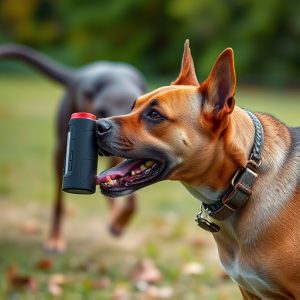Safe Spraying Distance for Dogs: Navigating Legal Use of Animal Control Sprays
Animal control spray (pepper spray) is a legal tool for managing aggressive dogs, repelling wildlife…….
Animal control spray (pepper spray) is a legal tool for managing aggressive dogs, repelling wildlife, and controlling feral populations, but its use requires adherence to strict guidelines. Maintaining a safe spraying distance of at least 10 feet (3 meters) from dogs is crucial for their safety, alongside proper aim and drying time. Following manufacturer instructions, using approved products, wearing protective gear, avoiding sensitive areas, securing storage, and responsible disposal are best practices for safe and effective use around pets.
Animal control sprays have become a common tool in managing unwanted animal interactions, but their legal use is a topic of growing interest. This article explores the legal framework surrounding these products, focusing on their application and safety, particularly regarding dogs. We delve into the recommended safe spraying distances to ensure effective yet responsible usage, providing pet owners with guidelines for both peace of mind and animal welfare.
- Understanding Animal Control Sprays and Their Legal Framework
- Safe Spraying Distance for Dogs: Guidelines and Best Practices
- Responsible Use and Safety Measures for Pet Owners
Understanding Animal Control Sprays and Their Legal Framework
Animal control sprays, also known as pepper spray or olfactant spray, are designed to deter and control animals without causing them harm. These chemicals create a temporary disabling effect, allowing individuals or communities to safely manage animal encounters. The legal framework surrounding these sprays varies by region, but they are often permitted for specific purposes like controlling aggressive dogs, repelling wildlife, or managing feral animal populations.
Knowing the safe spraying distance for dogs is crucial in ensuring responsible and legal use. Different pepper spray formulations have varying ranges, typically between 3 to 15 meters (10-50 feet). Users must follow manufacturer guidelines, understand the spray’s effectiveness, and be aware of local laws that dictate where and how these sprays can be deployed, especially around pets like dogs.
Safe Spraying Distance for Dogs: Guidelines and Best Practices
When considering the safe spraying distance for dogs, it’s crucial to adhere to guidelines and best practices to ensure minimal harm. According to experts, a general rule is to maintain a distance of at least 10 feet (3 meters) from dogs both during and after application. This measure helps prevent direct contact with spray particles, which can cause irritation or worse.
Best practices also include aiming the spray away from dogs and towards the intended target, such as problem wildlife or invasive species. Additionally, allowing sufficient time for the spray to dry before letting dogs re-enter the area is essential. Following these simple steps goes a long way in ensuring both animal safety and the effectiveness of the control measures.
Responsible Use and Safety Measures for Pet Owners
When considering using animal control spray, especially around pets, responsible use and safety measures are paramount. It’s crucial to always keep a safe spraying distance for dogs—typically recommended as at least 10 feet (3 meters)—to avoid any potential harm or distress. Pet owners should also ensure the spray is approved for use around animals and follow all product instructions carefully.
Safety gear, such as gloves and eye protection, can help safeguard both the user and pets from accidental exposure to the spray. Additionally, training and familiarity with the spray’s effects are essential. Never aim or spray at a pet’s face or directly into their eyes, nose, or mouth. Responsible use includes storing the spray securely out of reach of animals and disposing of it properly to prevent any environmental contamination.
Animal control sprays, when used responsibly and within legal boundaries, can effectively address unwanted animal behaviors. Understanding the safe spraying distance for dogs, as outlined in this article, is crucial for pet owners to ensure both their safety and that of their animals. By adhering to best practices and safety measures, individuals can leverage these tools to manage and mitigate potential risks associated with errant pet behavior while respecting legal guidelines.


